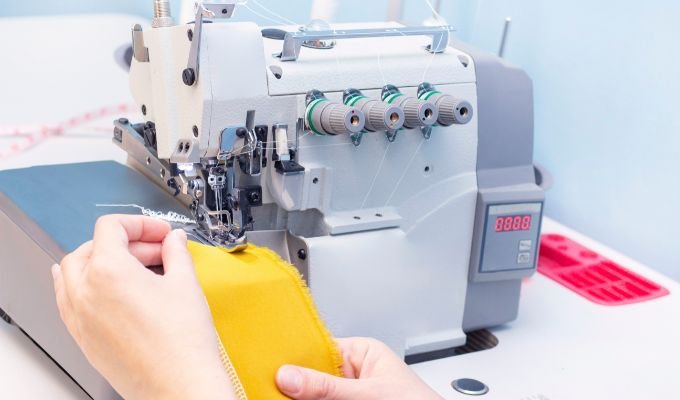Sewing and garment construction are just as important as cutting and sewing fabric when it comes to sewing and garment making. That is where overlockers come in—industrial sewing machines that cut, sew, and seal the edges of fabric in one smooth stroke.
Alternatively called sergers (particularly in America), overlockers are an indispensable tool for professional tailoring, fashion production, upholstery work, and domestic sewing. They prevent fraying, add stretch to knitwear, and lend clothing that same professional, shop-bought look. Whether a home hobbyist sewing for personal use or an industrial manufacturer mass-producing garments, overlockers are indispensable instruments that elevate your work from primitive to sophisticated.
Let’s discover what overlockers are, how they work, and why they’re so valuable in the sewing industry.
What Is an Overlocker?
An overlocker is a specialized sewing machine that overlocks stitches on the other side of fabric beyond the edge to give neater finish to seams, prevent running and incorporate stretch or reinforcement. Unlike a regular sewing machine, an overlocker runs on several threads (usually 3 to 5) and loopers instead of bobbins to create a locked interlocking stitch along the edge of the fabric.
A lot of overlockers have an integrated blade which trims the excess fabric during sewing, making the process a breeze and yielding a neat, smooth edge.
Principal Activities of an Overlocker
An overlocker does not just do sewing—it is all about finishing and functionality. This is what it can achieve:
1. Edge Finishing
Overlockers are most widely recognized to keep raw edges from fraying, particularly with woven fabrics.
2. Seam Construction
For elastic or knit textiles, overlockers can even sew the seams themselves and remain flexible—something a simple straight stitch can’t do without breaking.
3. Trimming
The cutting edge snips off fabric edges while you sew, giving a tidy, professional look with equal seam allowances.
4. Decorative Edging
Rolled hems and lettuce edges are popular decorative finishes that can be achieved with overlockers, especially on light fabrics.
5. Multi-thread Stitching
With 3 to 5 threads, overlockers create stronger, stretchy seams—perfect for sportswear, swimwear, or fitted fashion apparel.
Overlocker Machines by Type
Overlockers have variations depending on their threads and features. The most popular ones are:
3-Thread Overlocker – Best for basic edge finishing and lightweight materials.
4-Thread Overlocker – Has an added second needle for stronger seams and more stretch; best used for garment construction.
5-Thread Overlocker – Gives a straight safety stitch along with the overlock; used in industrial situations for heavy use.
Combination Machines (Overlocker/Coverstitch) – Some top-of-the-range machines offer overlocking and coverstitch capabilities within one piece of equipment, although they may have to be switched manually between the two.
Where Overlockers Are Used
Overlockers are required in professional and domestic sewing environments:
Fashion and Apparel Industry
Overlockers are widely utilized in bulk manufacture of apparel to deliver quick, clean, and powerful seam formation. Most apparel—especially knitwear—is made with overlockers.
Home Sewing and DIY
Home sewers use overlockers to provide home-made garments, curtains, cushions, and craftwork with a professional finish.
Tailoring and Alterations
Overlockers are utilized in tailoring shops for quick hemming, resizing, and trimming seams in garment alteration or repairs.
Upholstery and Home Decor
Overlockers for heavy-duty use can be used to hem edges of heavy material like canvas, denim, or leather for upholstery and furniture coverings.
Benefits of an Overlocker
Following is the benefit of overlockers among sewing aficionados and professionals alike:
Time-saving – Cut, sew, and finish in one pass.
Professional finish – Just like store-purchased garment stitches.
Durability – Overlocked seams withstand wear and washing longer.
Stretch compatibility – Sews stretch fabric and knits with ease.
Neater workspace – Built-in blade eliminates scissors in the middle of the seam.
Disadvantages of Overlockers
While versatile, overlockers are not a replacement for regular sewing machines. Here’s why:
They can’t sew zippers, buttonholes, or topstitching
Most sew only at the edge of fabric, not the center of fabric
The blade can destroy fabric if not treated carefully
They have a steeper learning process and can be intimidating for new operators
That being said, overlockers are a great addition to a conventional sewing machine, increasing your ability and heightening your finish quality.
Selecting the right Overlocker
When choosing an overlocker, keep the following things in mind:
Thread count (3-, 4-, or 5-thread)
Ease of threading – Color-coded lanes or automatic threading systems
Adjustable differential feed – Evenly stretches or gathers fabrics
Stitch variety – Rolled hems, flatlocking, and others
Speed and noise level – Particularly for home use
Brand reputation and support – Brands like Brother, Janome, Juki, and Baby Lock have good reputations for machines and simple customer support
If you’re just starting out, a good 4-thread model is usually a good place to start.
Maintenance and Care
To maintain your overlocker in the best condition:
Clean it regularly to collect lint and threads
Oil it as directed by the manufacturer
Change blades and needles as needed
Use high-quality thread to prevent breakage
Store it in a dust cover when not in use
Maintenance keeps stitches uniform in quality and extends the lifespan of your machine.

